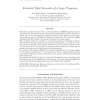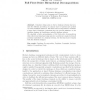3134 search results - page 28 / 627 » Computing full disjunctions |
COLING
1994
13 years 11 months ago
1994
A consistent text contains rich inforlnation for resolving mnbiguities within its sentences. Even simple syntactic information such as word occurrence and collocation patterns, wh...
ICLP
2010
Springer
14 years 1 months ago
2010
Springer
We define the Tight Semantics (TS), a new semantics for all NLPs complying with the requirements of: 2-valued semantics; preserving the models of SM; guarantee of model existence...
DNA
2005
Springer
14 years 3 months ago
2005
Springer
We introduce a class of generalized DNF formulae called wDNF or weighted disjunctive normal form, and present a molecular algorithm that learns a wDNF formula from training example...
ISMVL
1997
IEEE
14 years 2 months ago
1997
IEEE
The composition tree of a given function, when it exists, provides a representation of the function revealing all possible disjunctive decompositions, thereby suggesting a realiza...
WOLLIC
2009
Springer
14 years 4 months ago
2009
Springer
Abstract. Database design aims to find a database schema that permits the efficient processing of common types of queries and updates on future database instances. Full first-ord...


